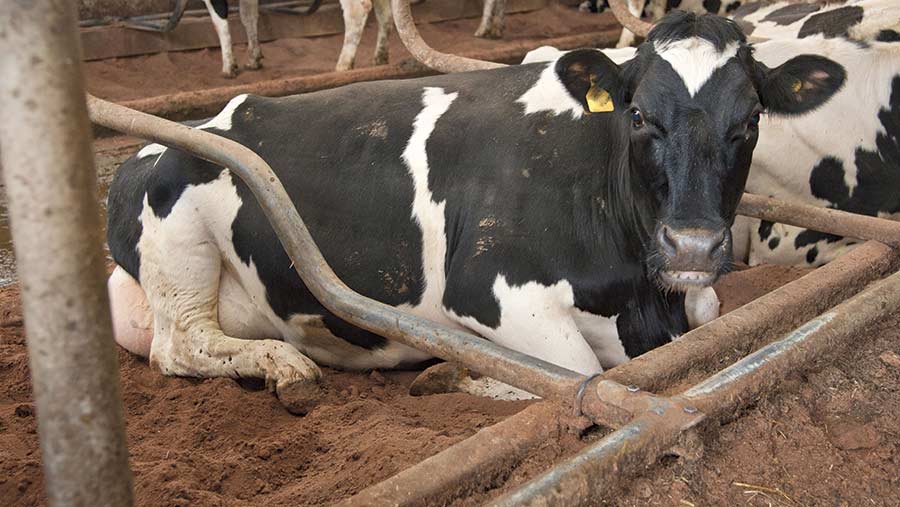6 alternative bedding options to straw compared
Poor weather conditions at harvesting and diminished crop yields on the back of a dry spring, coupled with strong demand from renewable energy plants, have converged to create an unprecedented scarcity of bedding-quality straw.
British Hay and Straw Merchants Association president Mike Evison says this shortage is being made worse by the fact there’s a reluctancy to sell.
See also: Livestock farmers warned to check woodchip bedding
“No farmer will sell straw on a rising market, so there is less being released for sale,’’ he admits.
But the good news for livestock farmers is that there are many alternative options available as winter bedding.

© FLPA/REX/Shutterstock
Key considerations
Straw is a good match for deep litter beds, but sawdust and sand can be used instead, says David Ball, AHDB Dairy technical manager for dairy farm buildings.
In dairy systems, deep sand is the optimum bedding material for cubicle housing, Mr Ball suggests. It provides an ideal lying surface which is soft, comfortable and dry.
Sand can also be used effectively in deep litter yards to reduce straw use, Mr Ball recommends.
“A layer of sand beneath the straw bedding will aid drainage and keep the straw drier,” he says.
A thin scattering of straw can be carefully removed from the sand when soiled, and a fresh layer added, to keep the bed clean.
Mr Ball cautions against using recycled woodchip made from products such as fencing posts or from MDF.
“There is a risk of contamination by screws, nails and staples, even if the chip has passed through a magnetic process to remove them,” he says.
“Woodchip from MDF kitchen units or similar can create a fine dust which is not good for human health, let alone livestock health.”
Whichever bedding material is used, it requires careful management to provide optimal lying conditions, says Mr Ball.
“It is essential that surfaces are kept dry and any soiled or damp product is removed,” he says.
If using products deemed as waste, such as untreated sawdust or paper, farmers need to register for a waste exemption with the Environment Agency or the equivalent regulator in devolved administrations.
Livestock bedding alternatives compared
|
Sawdust Prices vary between £50/t and £120/t, depending on if product is treated to prevent bacterial growth |
|||||
|
Pros |
Cons |
Absorbency |
Quantities required |
Animal health and welfare considerations |
Disposal |
|
Produces a comfortable, clean bed if managed carefully. Can be used for deep littering |
Needs to be changed regularly because dry matter decreases when it absorbs urine |
159.6ml/litre |
Each tonne will cover 100-120sq m at a depth of 5cm |
Damp sawdust can harbour moulds |
Can be spread on the land if from virgin wood |
|
Woodchip From £56/t |
|||||
| Pros | Cons | Absorbency | Quantities required | Animal health and welfare considerations | Disposal |
|
Can be re-used for numerous winters. Promotes high welfare and cleanliness and is readily available |
Adequate dry storage required. May contain nails or staples which could cause injury if using woodchip from recycled wood products |
247.6ml/litre |
27t will cover 800sq m at recommended 10cm depth |
Bacterial growth is limited and low dust burden Woodchip produced from virgin wood is a better fit for deep-bedded yards than cubicles It should be below 30% moisture for maximum absorbency |
Composted and screened Composted material spread on land and screened material preserved as next year’s bedding |
|
Paper Approximately £40-£85/t delivered, depending on the paper product |
|||||
| Pros | Cons | Absorbency | Quantities required | Animal health and welfare considerations | Disposal |
|
Easy to store and reasonably easy to dispose of |
Can leave bare patches on floor unless shredded into small pieces. Must be removed once wet or sets hard |
Highly absorbent if kiln dried to below 10% moisture content |
Beef and sheep require a 10cm depth at start of winter. Cows need 200kg a cow each winter |
Can heat up when wet and provide good conditions for pathogens to flourish |
May clump and be difficult to spread; also a risk of increasing the nitrogen requirement of soils |
|
Calcium carbonate £53/t excluding delivery |
|||||
| Pros | Cons | Absorbency | Quantities required | Animal health and welfare considerations | Disposal |
|
Doesn’t support bacterial growth so won’t contribute to the spread of bacteria |
Highly alkaline and used on its own may cause scalding of teats in cows or noses in lambs and calves |
Highly absorbent |
500g/cubicle bed/day |
Doesn’t introduce bacteria to the bed |
Can be spread on fields but advisable to analyse soils first because of its alkaline nature |
|
Crushed husks £50-£100/t |
|||||
| Pros | Cons | Absorbency | Quantities required | Animal health and welfare considerations | Disposal |
|
Readily available all year round Can be mixed with other products such as lime |
Must be stored in dry conditions Advisable to use an anti-bacterial bedding powder in conjunction with this product |
6-8% moisture content |
Similar quantities to sawdust |
Doesn’t set hard on beds and remains free flowing for cow comfort |
Biodegradable so can be spread on land |
|
Sand About £9/t (collected) |
|||||
| Pros | Cons | Absorbency | Quantities required | Animal health and welfare considerations | Disposal |
|
Produces a clean, dust-free and well-drained bed Can be used for deep-litter beds |
Can accelerate wear in slurry/muck handling equipment and concrete surfaces |
0.3 litre/kg |
In deep-bed systems farmers using sand report starting with an initial 20-30cm of sand and replenishing as necessary; typical use in cubicles 7.5-10kg a cow a day |
Can stick to teats and udder and wear hooves |
Can be spread on the land, but be aware of long-term effect on soil pH |
